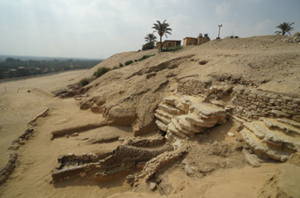Nozomu KAWAI
Since 1988, I have participated in several archaeological field work in Egypt, including Luxor (Ancient Thebes), Giza, Dahshur North, Abusir South and etc. Through these experiences, I have been working on the burial customs, political and cultural histories of the New Kingdom in Ancient Egypt, particularly focusing on the so-called “Amarna Period” from the reign of Amenhotep III to the aftermath of the reign of Tutankhamun by synthesizing archaeological evidence, textual evidence, and iconographic evidence. I have also directed the excavations at Abusir South where we found an Early Dynastic stone structure and its substructure, Middle Kingdom rock-cut chambers, a multiple burial dating to the end of the Second Intermediate Period, a New Kingdom tomb chapel, and votive activities dating to the Late Period. These excavations have revealed the development of a sacred place in Ancient Egypt.Since 2015, I began surveying at North Saqqara plateau in order to explore unknown New Kingdom cemetery(or cemeteries) because our knowledge of the New Kingdom tombs has been meager although Memphis was the center of administration and economy during the New Kingdom, while the New Kingdom tombs have been vigorously investigated in the past 150 years. In 2017, we began a sounding excavation at the eastern escarpment of Saqqara plateau and subsequently discovered a Roman catacomb dating to the first century AD. Adjacent to the catacomb, we have revealed tomb dating to the Dynastic Period. Assumingly, there might exist cemetery extending 1km north to south. It is hoped to excavate the Pharaonic tombs this area in the years to come.
主な論文
・Kawai, N. (in press) “Tutankhamun in Heliopolis,” In Beloved of Seshat: Essays in Honour of Fayza Heikal, London: Golden House Pub
・Kawai, N. (2019) “The statues of Lioness Goddess at the Rock-Cut Chambers at Northwest Saqqara and Their Funerary Cult in the Middle Kingdom Egypt,” In Proceedings of the International Workshop on Women’s Religious and Economic Roles in Antiquity, pp. 63-71. Tokyo: Chuo University.
・Kawai, N. and Kondo, J. (2017) “Discovered, Lost, Rediscovered: Userhat and Khonsuemheb,” Egyptian Archaeology, vol. 50, pp. 12-16.
・Kawai, N. (2015) “The New Kingdom Tomb Chapel of Isisnofret at North Saqqara,” In Quest for the Dream of the Pharaohs: Studies in Honour of Sakuji Yoshimura, Supplément aux annales du service des antiquiteés de l’Égypte Cahier no. 43 69–90.
・Kawai, N. (2013) “Some Remarks on the Funerary Equipment from the tomb of Amenhotep III (KV 22),” In Archaeological Research in the Valley of the Kings and Ancient Thebes, Tucson: University of Arizona Egyptian Expedtion, pp. 149-172.
・Kawai, N. (2011) “An early cult centre at Abusir-Saqqara? Recent discoveries at a rocky outcrop in north-west Saqqara,” In Egypt at its Origins 3: Proceedings of the Third International Conference “Origin of the State. Predynastic and Early Dynastic Egypt” London, 27th July – 1st August 2008, pp. 801-830.
・Kawai, N. (2010) “Ay versus Horemheb: The Political Situation in the Late Eighteenth Dynasty Revisited,” Journal of Egyptian History, vol. 3-2, pp. 261-292.
・Kawai, N. (2006) Studies in the Reign of Tutankhamun, Department of Near Eastern Studies, The Johns Hopkins University, Ann Arbor: University Microform International.









